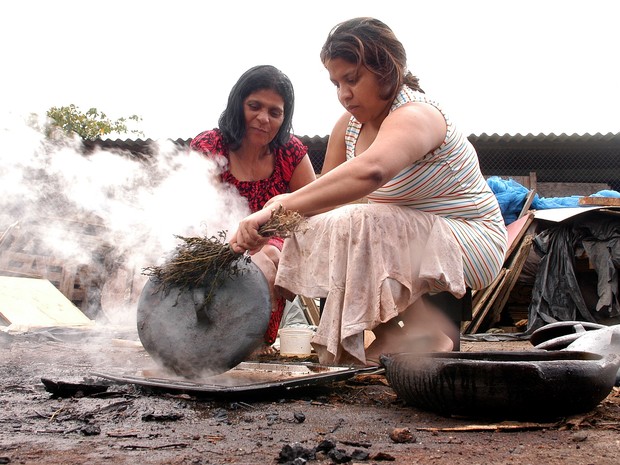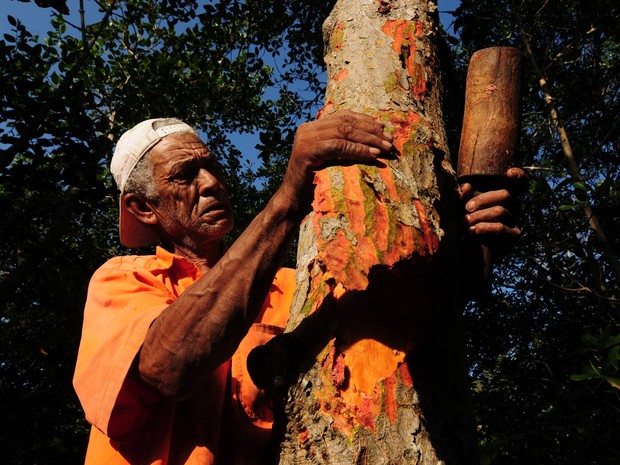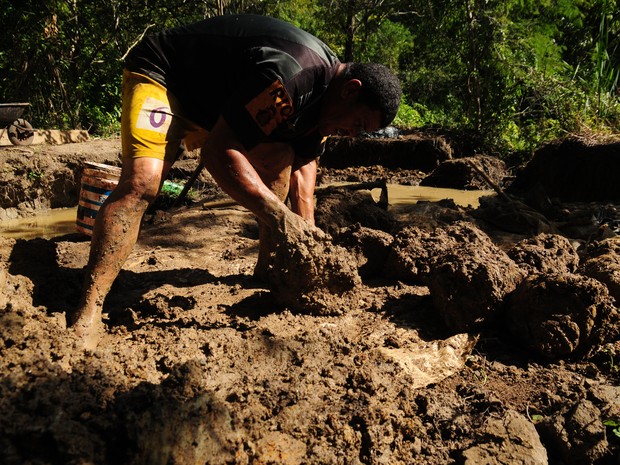Nas mãos habilidosas das paneleiras de Goiabeiras, em Vitória, é que a argila toma forma e se transforma na famosa panela de barro capixaba. O trabalho, totalmente artesanal e reconhecido nacionalmente, dá o sustento de muitas famílias, e é motivo de orgulho e alegria. “Sou privilegiada por ter essa profissão”, contou uma paneleira.
O artesanato das paneleiras de Goiabeiras foi tombado pelo Instituto do Patrimônio Histórico e Artístico Nacional (Iphan). No dia delas, celebrado nesta terça-feira (7), o G1 esteve no galpão onde as peças são feitas e gravou as etapas da confecção desta tradicional peça.
A paneleira Eronildes Correa, de 49 anos, exerce a atividade há 37 anos. Boa parte da família dela também trabalha com a produção da panela de barro. Além dela, duas irmãs, dois irmãos, um sobrinho e o filho caçula participam de pelo menos algum processo na fabricação das panelas.
 Mariane Correa ensina a filha a tingir a panela de barro
Mariane Correa ensina a filha a tingir a panela de barro
(Foto: Gildo Loyola/ A Gazeta - 31/08/2007)
"Fazer parte disso é uma honra.
É um trabalhado árduo,
que não é copiado, mas herdado"
Eronildes Correa, paneleira há 37 anos
“Comecei e até hoje não larguei. É um trabalho divulgado em todo o mundo. Já ganhamos referência em Dubai, título de bem material, título de procedência. Fazer parte disso é uma honra. É um trabalhado árduo, que não é copiado, mas herdado”, contou Eronildes, que prefere ser chamada como Eroni.
E de acordo com ela, a crise econômica ainda não chegou às paneleiras. “Aqui não tem crise, aqui tem fé e força de vontade para vencer”, disse.
Irmã de Eroni, a também paneleira Eonete Fernandes, de 65 anos, conta que a história da família se mistura à da tradição paneleira.
“Minha mãe foi mãe de 14 filhos e fez panela até os 81 anos. Ela dependia de panela, era o pão de cada dia da família. Era muita luta e a gente ajudava minha mãe, foi uma infância dura mesmo” , contou.
Paneleira há 45 anos, ela é aposentada por outra atividade, mas continua confeccionando panelas. “Eu continuo porque gosto, é uma atividade que faz bem. Sou uma privilegiada de ter essa profissão. Para mim é um orgulho ser paneleira”, disse Eonete.
Nesta terça-feira (7), foi comemorado o Dia das Paneleiras. A presidente da Associação das Paneleiras de Vitória, Marinete Loureiro, contou que o dia foi escolhido para ser celebrado na data de aniversário da Associação. “É o nosso dia, devia até ser feriado”, brincou.
 Extração da casca da árvore do Mangue Vermelho para fazer o tanino (Foto: Gabriel Lordêllo/ A Gazeta - 13/06/2011)
Extração da casca da árvore do Mangue Vermelho para fazer o tanino (Foto: Gabriel Lordêllo/ A Gazeta - 13/06/2011)
Para ela, manter viva um tradição que atravessa gerações é motivo de muito orgulho. “Nossos antepassados deixaram esse trabalho e nós continuamos sem mudar nenhuma característica. É de geração, é muito prazeroso preservar a cultura”, disse.
Mesmo quando ainda morava fora do estado, ela já conhecia o trabalho das paneleiras de Goiabeiras e se realizou ao poder conhecer a confecção.
Clientela
A nutricionista Emília Torres de Castro é de Minas Gerais, morou em Brasília e se mudou para o Espírito Santo, Brasil, há poucos dias.
“Sempre tive vontade de conhecer o trabalho de perto, já assisti documentários lá em Brasília. Por coincidência, vim parar aqui no Dia das Paneleiras. É um trabalho maravilhoso, eu dou o maior valor, é uma matéria-prima e dá condições para o pessoal utilizar, ganhar a vida e proporcionar à população um utensílio de boa qualidade. Queria levar uma panela hoje, mas estou á pé. Pena que não tem delivery”, brincou.
Patrimônio Cultural Brasileiro
A arte de confeccionar as panelas de barro foi herdada das culturas tupi-guarani e transmitida por várias gerações. Desde 2002, o ofício de fazer panelas de barro é reconhecido nacionalmente como um Bem Cultural de Natureza Imaterial e titulado como Patrimônio Cultural Brasileiro.
A inclusão das paneleiras como Patrimônio Cultural Brasileiro foi uma iniciativa do Ministério da Cultura e do Instituto do Patrimônio Histórico e Artístico Nacional (Iphan). A medida se tornou possível por intermédio do Decreto Federal 3.551/2000, que instituiu o registro de bens culturais de natureza imaterial.
‘Fazer parte disso é uma honra’,
diz paneleira do ES sobre a atividade
(Foto: Naiara Arpini/ G1)
Trabalho manual
A modelagem das panelas é feita manualmente. A parede da panela é levantada por meio do uso de roletes ou escavada na "bola" de argila, quando é "puxada". Para isso são utilizados os movimentos das mãos, tanto circulares como verticais, abaulando, arredondando, definindo o formato da peça com a ajuda de ferramentas rudimentares, como pedras lisas, cascas de coco, cuité (pedaço de cabaça) e objetos similares. É o mesmo procedimento utilizado pelos povos indígenas que habitaram Vitória há mais de 400 anos.
A característica mais marcante das panelas é a coloração escura. Isto é obtido por meio da impregnação do tanino na peça. A casca é retirada do tronco por meio de golpes de um porrete de madeira. As lascas da Rhysophora mangle, o mangue vermelho, são picadas e colocadas de molho em água doce, para curtir dessa forma em um máximo de três dias.
 Busca pelo tanino, no Mangue Vermelho
Busca pelo tanino, no Mangue Vermelho
(Foto: Gabriel Lordêllo/ A Gazeta - 13/06/2011)
 Extração de barro no Vale do Mulembá, em Vitória
Extração de barro no Vale do Mulembá, em Vitória
(Foto: Gabriel Lordêllo/ A Gazeta - 13/06/2011)
Cultura e conhecimento são ingredientes essenciais para a sociedade.
A cultura é o único antídoto que existe contra a ausência de amor
Vamos compartilhar.
--in via tradutor do google
Brazilian Culture - CUISINE - Paneleiras of Goiabeiras. Tumbled by the Historical and Artistic Heritage Institute. Espírito Santo, Brazil.
In the skilled hands of the potters of Goiabeiras in Victoria, it is the clay takes shape and becomes the famous pot capixaba clay. The work, entirely handmade and nationally recognized, gives the livelihood of many families, and is a source of pride and joy. "I am privileged to have this profession," he told a paneleira.
The craftsmanship of Goiabeiras potters was listed by the Heritage Institute for National Artistic (IPHAN). In their day, celebrated on Tuesday (7), the G1 was the shed where parts are made and recorded the stages of preparation of this traditional piece.
The paneleira Eronildes Correa, 49, carries on business for 37 years. Much of her family also works with the production of clay pot. Besides her, two sisters, two brothers, a nephew and youngest child participate in at least some process in the manufacture of cookware.
Mariane Correa teaches daughter to dye the clay pot
(Photo: Gildo Loyola / The Gazette - 31/08/2007)
"Being part of that is an honor.
It is a hard working,
it is not copied, but inherited "
Eronildes Correa, paneleira 37 years
"I started and still not dropped. It is a work disclosed worldwide. We've earned benchmark in Dubai, title and material, title of origin. Part of it is an honor. It is a hard working, which is not copied, but inherited, "said Eronildes, who prefers to be called as Eroni.
And according to her, the economic crisis has not yet reached the potters. "There is no crisis here has faith and will to win," he said.
Sister Eroni the paneleira also Eonete Fernandes, 65, says that the family history mixes with the paneleira tradition.
"My mother was the mother of 14 children and made pan until 81 years. She depended pot, was the daily bread of the family. It was a lot of fighting and we helped my mother was a hard childhood even, "he said.
Paneleira for 45 years, she is retired by another activity, but still fashioning pots. "I continue because I like it, it is an activity that is good. I am privileged to have this profession. For me it is an honor to be paneleira "Eonete said.
On Tuesday (7), the Day was celebrated Potters. The president of the Association of Potters of Victoria, Marinete Loureiro, said that the day was chosen to be celebrated on the anniversary date of the Association. "It is our day, was to be holiday," he joked.
Tree bark extraction
Red Mangrove to the tannin
(Photo: Gabriel Lordello / The Gazette - 13/06/2011)
For her, keeping alive one tradition that spans generations is a source of great pride. "Our ancestors left this work and we continue without changing any feature. It's generation, is very pleasant to preserve the culture, "he said.
Even while living out of state, she already knew the work of potters of Goiabeiras and was held to get to know the making.
Clientele
Nutritionist Emilia Castro Torres is Minas Gerais, he lived in Brasilia and moved to the Holy Spirit, Brazil, a few days ago.
"I always wanted to know the work closely, I watched documentaries already there in Brasilia. By coincidence, I got here on the day of the Potters. It is a wonderful job, I give the highest value, it is a raw material and gives conditions for personal use, earn a living and provide the population a tool of good quality. I wanted to take a pot today, but I'm on foot. Too bad it does not have delivery, "he joked.
Brazilian Cultural Heritage
The art of making the clay pots was inherited from the Tupi-Guarani cultures and transmitted for generations. Since 2002, the craft of making clay pots is nationally recognized as a Cultural Intangible Nature Well and titrated as Brazilian Cultural Heritage.
The inclusion of potters as Brazilian Cultural Heritage was an initiative of the Ministry of Culture and Historical Heritage Institute for National Artistic (IPHAN). The measure is made possible through the Federal Decree 3.551 / 2000, which established the record of cultural assets of an intangible nature.
'Being part of this is an honor'
says paneleira ES on activity
(Photo: Naiara Arpini / G1)
Handwork
The modeling of the cookware is made manually. The wall of the pot is raised through the use of rollers or cut into the "ball" clay when it is "pulled". For this the hand movements are used, both circular and vertical, bulging, rounded off by setting the shape of the part with the help of rudimentary tools such as smooth stones, coconut shells, Cuité (piece of gourd) and similar objects. It is the same procedure used by the indigenous peoples who inhabited Victoria for over 400 years.
The most striking feature of the pans is the dark coloration. This is obtained by impregnating the piece tannin. The bark is removed from the trunk moves through a wooden stick. Splinters of Rhysophora mangle, the red mangrove, are chopped and put to soak in fresh water to enjoy this way in a maximum of three days.
Search for tannin in red Mangue
(Photo: Gabriel Lordello / The Gazette - 13/06/2011)
clay extraction in the valley of Mulembá in Victoria
(Photo: Gabriel Lordello / The Gazette - 13/06/2011)
Cultura e conhecimento são ingredientes essenciais para a sociedade.
A cultura é o único antídoto que existe contra a ausência de amor
Vamos compartilhar.
--in via tradutor do google
Brazilian Culture - CUISINE - Paneleiras of Goiabeiras. Tumbled by the Historical and Artistic Heritage Institute. Espírito Santo, Brazil.
In the skilled hands of the potters of Goiabeiras in Victoria, it is the clay takes shape and becomes the famous pot capixaba clay. The work, entirely handmade and nationally recognized, gives the livelihood of many families, and is a source of pride and joy. "I am privileged to have this profession," he told a paneleira.
The craftsmanship of Goiabeiras potters was listed by the Heritage Institute for National Artistic (IPHAN). In their day, celebrated on Tuesday (7), the G1 was the shed where parts are made and recorded the stages of preparation of this traditional piece.
The paneleira Eronildes Correa, 49, carries on business for 37 years. Much of her family also works with the production of clay pot. Besides her, two sisters, two brothers, a nephew and youngest child participate in at least some process in the manufacture of cookware.
Mariane Correa teaches daughter to dye the clay pot
(Photo: Gildo Loyola / The Gazette - 31/08/2007)
"Being part of that is an honor.
It is a hard working,
it is not copied, but inherited "
Eronildes Correa, paneleira 37 years
"I started and still not dropped. It is a work disclosed worldwide. We've earned benchmark in Dubai, title and material, title of origin. Part of it is an honor. It is a hard working, which is not copied, but inherited, "said Eronildes, who prefers to be called as Eroni.
And according to her, the economic crisis has not yet reached the potters. "There is no crisis here has faith and will to win," he said.
Sister Eroni the paneleira also Eonete Fernandes, 65, says that the family history mixes with the paneleira tradition.
"My mother was the mother of 14 children and made pan until 81 years. She depended pot, was the daily bread of the family. It was a lot of fighting and we helped my mother was a hard childhood even, "he said.
Paneleira for 45 years, she is retired by another activity, but still fashioning pots. "I continue because I like it, it is an activity that is good. I am privileged to have this profession. For me it is an honor to be paneleira "Eonete said.
On Tuesday (7), the Day was celebrated Potters. The president of the Association of Potters of Victoria, Marinete Loureiro, said that the day was chosen to be celebrated on the anniversary date of the Association. "It is our day, was to be holiday," he joked.
Tree bark extraction
Red Mangrove to the tannin
(Photo: Gabriel Lordello / The Gazette - 13/06/2011)
For her, keeping alive one tradition that spans generations is a source of great pride. "Our ancestors left this work and we continue without changing any feature. It's generation, is very pleasant to preserve the culture, "he said.
Even while living out of state, she already knew the work of potters of Goiabeiras and was held to get to know the making.
Clientele
Nutritionist Emilia Castro Torres is Minas Gerais, he lived in Brasilia and moved to the Holy Spirit, Brazil, a few days ago.
"I always wanted to know the work closely, I watched documentaries already there in Brasilia. By coincidence, I got here on the day of the Potters. It is a wonderful job, I give the highest value, it is a raw material and gives conditions for personal use, earn a living and provide the population a tool of good quality. I wanted to take a pot today, but I'm on foot. Too bad it does not have delivery, "he joked.
Brazilian Cultural Heritage
The art of making the clay pots was inherited from the Tupi-Guarani cultures and transmitted for generations. Since 2002, the craft of making clay pots is nationally recognized as a Cultural Intangible Nature Well and titrated as Brazilian Cultural Heritage.
The inclusion of potters as Brazilian Cultural Heritage was an initiative of the Ministry of Culture and Historical Heritage Institute for National Artistic (IPHAN). The measure is made possible through the Federal Decree 3.551 / 2000, which established the record of cultural assets of an intangible nature.
'Being part of this is an honor'
says paneleira ES on activity
(Photo: Naiara Arpini / G1)
Handwork
The modeling of the cookware is made manually. The wall of the pot is raised through the use of rollers or cut into the "ball" clay when it is "pulled". For this the hand movements are used, both circular and vertical, bulging, rounded off by setting the shape of the part with the help of rudimentary tools such as smooth stones, coconut shells, Cuité (piece of gourd) and similar objects. It is the same procedure used by the indigenous peoples who inhabited Victoria for over 400 years.
The most striking feature of the pans is the dark coloration. This is obtained by impregnating the piece tannin. The bark is removed from the trunk moves through a wooden stick. Splinters of Rhysophora mangle, the red mangrove, are chopped and put to soak in fresh water to enjoy this way in a maximum of three days.
Search for tannin in red Mangue
(Photo: Gabriel Lordello / The Gazette - 13/06/2011)
clay extraction in the valley of Mulembá in Victoria
(Photo: Gabriel Lordello / The Gazette - 13/06/2011)






Nenhum comentário:
Postar um comentário